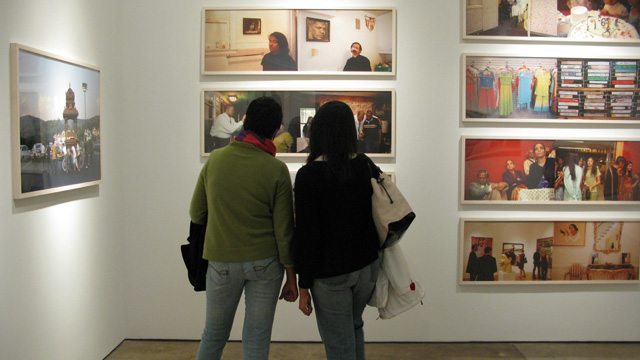
Look – and you will find yourself.
 When you look at Gauri Gill’s images in her touring collection ‘The Americans’, it sometimes feels as if you’re gazing into a mirror and seeing a reflection of yourself. Indeed, there will be few immigrants who do not see a piece of themselves, a bit of their story echoed in her photographs.
When you look at Gauri Gill’s images in her touring collection ‘The Americans’, it sometimes feels as if you’re gazing into a mirror and seeing a reflection of yourself. Indeed, there will be few immigrants who do not see a piece of themselves, a bit of their story echoed in her photographs.
You see a well-heeled couple, IT professionals, rushing to work from their McMansion in the suburbs, each getting into their own shiny sedan, off to fulfilling their American dream.
You see smiling, psyched out young men and women sitting at a speed dating session organized by Gujarati parents – a whiff of east in west that many second generation Indian Americans will be familiar with.

A solitary old Sikh gentleman bicycles in a quiet suburb of Americana, with electoral signage dotting the landscape. An American flag dangles from his bike. Yes, this too is home, though he may still ache for the mustard fields of the Punjab.
With her unerring eye and ability for juxtaposing past and present, of catching moments of truth, Gauri Gill is almost a social anthropologist, capturing the stories which would otherwise fade and disappear if they were not caught by the all seeing and candid lens of her camera.
Whether it’s peach farmers in Yuba City, dandiya dancers in Edison, NJ, or IT professionals in Silicon Valley, Gill catches all the nuances of lives lived far from the homeland, lives of compromises and adjustments, of loss and some gain.
Gill went into nooks and corners of America and discovered stories of Indian migration playing out. After attending community celebrations marking Guru Nanak’s birth, she hitched a ride from Yuba City with an elderly Sikh couple in an old pick up truck who were driving to Fremont. She was startled to realize they could not read English or any of the road signs yet were driving hundreds of miles, having simply memorized the route!
She recalls, “They were driving on these highways and I thought that’s what is so fantastic about the immigrant experience – it’s a beast where you can just get up and go out and do it. It shows raw courage and attitude – I think we are in some ways more intimidated.”

This photo documentary project, which was shown in New York at the Bose Pacia Gallery, is currently touring internationally. “As we have all come to know, the South Asian Diaspora in America is a wild and dynamic mix of tenacious traditionalism and postmodern sophistication that defies comparison with any other immigrant group,” observes critic Michael Weinstein. “Gauri Gill, who offers up lucid color photographs of Indian Americans from across the country in varied settings and activities, is exquisitely successful in capturing the complexity and underscoring a singular vitality.”
Gill, who lives in Delhi, has herself spent several years as a student in the US, so the agonies and the compromises, the daily challenges of immigrants are not unknown to her. Born in Chandigarh, Gill spent her growing up years between the two cities, and in boarding school in Himachal Pradesh when her father, who was in the civil service, was based in Nigeria.
“My mother was a school teacher but has also painted quite consistently all her life so I grew up with her art and my dad’s constant photography of us and of all of his travels,” recalls Gill. She got hooked to photography while studying at the Delhi School of Art for her BFA in Applied Art, and later got a scholarship to study documentary photography at Parsons in New York.
In 2002 she received an MFA in Photography from Stanford University in California. She says, “One could not and still to date sadly cannot get a BFA or MFA in photography in India. I hope that will change soon; there are possible programs in the works.”
Asked how she managed to capture the nuances of Indian-American life in her photographs, she says, “I was a part of that world myself so I just tried to tell the story as I saw it, starting with family and friends and extending outwards to strangers. It was made while I lived in New York, Washington DC and California, and on trips out to the Midwest and through the South.”
Gill’s photos take you into a remarkable immigrant world where tradition lives on, though it is reinvented, with Hindu thread ceremonies taking place in strip malls and gurudwaras being created in basements. Immigrant lives are full of nostalgia for past and that past is brought to the present in various transplanted celebrations.
“Here Lycra meets Punjabi bling and the bhangra is danced against the backdrop of the American flag,” writes Gayatri Sinha, an independent curator and critic. “Temple rathas are pushed along by software engineers and photos of the gods flank images of Frisco’s golden bridge. In a country where culture is manifest as visible material effects, Indianness can gain a push button dimension, switched on for the moments of high spectacle.”
Having lived in the US and spent so many of her student years here, does she consider herself an Indian-American or an Indian? “If I had to pick one I would say Indian, because that is where I have lived the longest, and where I live now, but I have many debts to America, including wonderful friends I have had, artists I like, and teachers. There are many things from the States that I have absorbed, so it’s hard to deny that part of my identity.”
While life for her in both India and America revolves around work and family, she points out an interesting difference: “In India there are more bells ringing, people dropping by, power cuts, traffic issues, all the time but it’s also quite human in that you’re all in the same boat, and very involved in other people’s lives all the time. Things don’t always run smoothly and there are constant dramas, which is fun!”
One of the most poignant images in The Americans is of an old gentleman sitting alone in the richly furnished living room of his son’s home in American suburbia. On the mantelpiece is a garlanded photograph of his wife. You understand she is no longer living and you almost are within the image, wondering what went before and what will happen later. It’s as rich a tapestry as a novel, with tightly corked emotions.
The photographs have narratives, almost like short stories, leaving viewers to guess the endings. What are her thoughts when she’s shooting these images?
Says Gill, “I’m just trying to be true to what I see and understand of the people and places I am in. I have met really great people with amazing stories so that was obviously in my head and heart, but in the end when one’s taking pictures the act is instinctive.”
Her innate curiosity about ordinary people and the lives lived has taken her to diverse communities, to delve beneath the layers “to make the unseen visible and perhaps understood.” Her critically acclaimed body of work includes Rural Rajasthan, Urban Landscapes and Nizamuddin at Night. Recently viewers also got to see her work from her time in Kabul and working with Afghani Sikhs in Delhi, looking at the experience of migration and memory.

In ‘The Americans’, one of the most poignant images is of a funeral in America as family and friends gather around the deceased, taxi driver Prem Kumar Walekar who was shot dead at a gas station in Rockville, Montgomery by a sniper. A journey has finally ended, and there’s no going back to India. One wonders what thoughts are going through people’s minds as they go through the motions.
The adjacent portrait is of Walekar’s young, grim-faced son outside, dressed in black. As mourners embrace each other, the dappled sunlight is reflected on manicured lawns and you get the sense somehow that they will all drive back to their homes, saddened and heavy hearted, but life will go on…
Gauri Gill has literally captured living and dying in America.
Her collection is appropriately enough called ‘The Americans’ because whether we admit it or not, accept it or not, each step of the journey away from India is taking us further and further away, into a new life and a new adventure – of becoming American.
Text © Lavina Melwani
This article first appeared in Khabar magazine
Photographs from The Americans © Gauri Gill
Photograph at Art Gallery – Credit: Sadia Rehman
